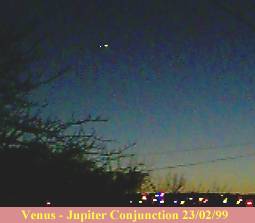Jupiter and Venus coming so close that they appear to merge as one bright star as they did on the morning of the 17th June 2 BC is a very rare event. It means the two planets must get nearer to each other than 3 arc minutes. On average it does this about once every 40 years at a particular site. However in order for it to be visible it must happen after the sun has set and while the planets themselves are above the horizon; that is during dusk or dawn. This makes viewing this phenomenon very rare indeed. For example there were only 3 such possible events in the period 800 BC - 1 BC. (719 BC, 618 BC and of course 2 BC).
The thing that makes this set of conjunctions unusual is two fold. Firstly the second conjunction was the closest for 600 years. Secondly never in the previous 80 years had 3 close conjunctions occurred in 3 consecutive years. (The previous time was 83 BC - 86 BC.)
 To give you some idea of what they would look like, the full moon is 30' across. This photo taken by the author shows a recent conjunction of Venus and Jupiter with a separation of 6' as it was in the final conjunction in 1 BC.
To give you some idea of what they would look like, the full moon is 30' across. This photo taken by the author shows a recent conjunction of Venus and Jupiter with a separation of 6' as it was in the final conjunction in 1 BC.Although these conjunctions are of two 'stars', it could more properly be described as a single star because of the closeness of the two planets. On the second occasion it would have been impossible to resolve the apparition as two stars. The wise men would have known that it was two stars, of course, but a layman like Matthew might not have realized the finer distinction. Another advantage to this theory is that it doesn't rely upon Astrology, but upon prophetic interpretation. This means that there would have been no objection from the early church as to its inclusion by the gospel writers. In fact, as we have seen, the 'Morning Star' imagery is used a lot in both the Old and New Testament.
This betters the first theory because it gives a gap between the first and third conjunction of exactly 2 years. This is in keeping with the time the Magi gave to Herod.
It occurs too late for the accepted 4 BC death of Herod. If this was so, he couldn't have sent the Wise Men on to Bethlehem. Although the first conjunction was seen in the east, the second, merging conjunction would have been seen in the west. Also the Bible makes no mention of this third 'western' sighting of the star. However the Bible text doesn't rule it out either.
The other problem is that the 3rd conjunction would have appeared as 2 stars; the Bible says 'the Star'. However, the previous 2 sightings did look like one star, and so in describing the 3rd event it would not be unreasonable to call it 'a star' too.
Timing - Too late.
Repeatability - YES
Direction - YES
Theology - YES
Historic/Scientific credibility - No problems
 - Click here to return to the Index.
- Click here to return to the Index. - Click here to return to the Homepage.
- Click here to return to the Homepage. The Theories.
The Theories.